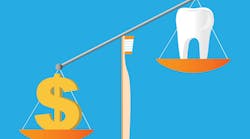Does digitizing the patient journey enhance or detract from their experience? A Gen X perspective
Digital vs. analog: Is digital always better?
Technology is everywhere. Some technology has made our lives easier, but those who grew up without smartphones (Gen X) often pity those who did. We may criticize generations behind us for “lacking communication skills” or “not getting enough outdoor playtime.” We’re grateful we didn’t have every moment of our younger years documented as a photo or video that was shared for all to see.
Having said this, technology in a dental practice is vital; it offers numerous efficiencies, demonstrates a commitment to staying up-to-date, and addresses the ever-evolving needs of our patients. With the current staffing challenges, technology can alleviate many tasks that were historically accomplished by team members. The possibilities are limitless; we can replace administrative tasks with software systems that schedule appointments; create appointment reminders; replace phone inquiries with text messaging or online chats; and access insurance verification, payment processing, and insurance submissions.
These systems can reduce the workload of team members and in some cases, reduce the number of employees. This may improve systems, build in efficiencies, and minimize human error, which are all beneficial to the practice. However, patient perception is valid; some patients may prefer technology, while others may prefer human interaction.
From a clinical perspective, technological advances have improved our ability to diagnose, treatment plan, and carry out a variety of dental procedures with more efficiency and patient comfort. Many dental practices are capable of a fully digital workflow to plan and place dental implants or fabricate indirect restorations.
The difference between clinical vs. administrative technology is that dental professionals have the opportunity to describe the advantages of the clinical technology they employ and celebrate these advancements with patients. Patients are often impressed by practices that use technology that performs procedures faster and with excellent outcomes.
The educational approach to introducing technology to patients in the clinical example I shared enables them to learn the benefits of and ultimately embrace technology. In contrast, when a patient encounters technology that they’re unaccustomed to, challenges can arise that may negatively impact their experience.
It’s worthwhile to understand the needs of each patient and educate them as their journey transitions from analog to digital. Effective communication will likely improve patient acceptance of newly implemented technology. While technology makes our lives easier, we must always remember that many patients appreciate certain aspects of human interaction in their journey; the fun part is identifying what that is!
Selecting technology
When planning new technology, consider what the purchase will do for your practice. In other words, identify a problem that the tech purchase will solve or minimize. Some technology is costly and poor planning may result in equipment that “collects dust” or “lives in a closet.” Considerations that aid in successful technology implementation include:
- Creates efficiencies: When a practice or team is overloaded and needs efficiencies to be able to accommodate more patients, technology can be particularly useful.
- Has team buy-in: If the team isn’t engaged with the new technology, implementation can be challenging. Solicit input from them when considering new technology. Generate excitement around the acquisition and involve the team with training and onboarding.
- Offers new services: Technology that introduces new services tends to be implemented successfully. For example, an intraoral scanner can be useful when introducing clear aligners or in-office milling of dental restorations. In addition, a CBCT can be useful when treating sleep patients or introducing implant placement. These purchases tend to provide a ROI.
- Create a plan: Use the team when training and onboarding is complete to discuss how the technology will be introduced to patients.
Finding the right technology that will enhance patient care and practice revenues can be very advantageous. It can lead to reigniting passions for the practice of dentistry, increasing new-patient referrals, and a positive reputation for the practice in the community. Identifying workflows or procedures that would be improved or introduced with new services or equipment will help ensure successful integration.
About the Author
Pamela Maragliano, DMD
Chief Editor of Dental Economics
Pamela Maragliano, DMD, is the chief editor of Dental Economics. Based in Salem, Massachusetts, Dr. Maragliano began her clinical career as a dental hygienist. She went on to attend Tufts University School of Dental Medicine, where she earned her doctorate in dental medicine. She then attended the University of California, Los Angeles, School of Dental Medicine, where she became board-certified in prosthodontics. Dr. Maragliano owns a private practice, Salem Dental Arts, and lectures on a variety of clinical topics. You may contact her at [email protected].



